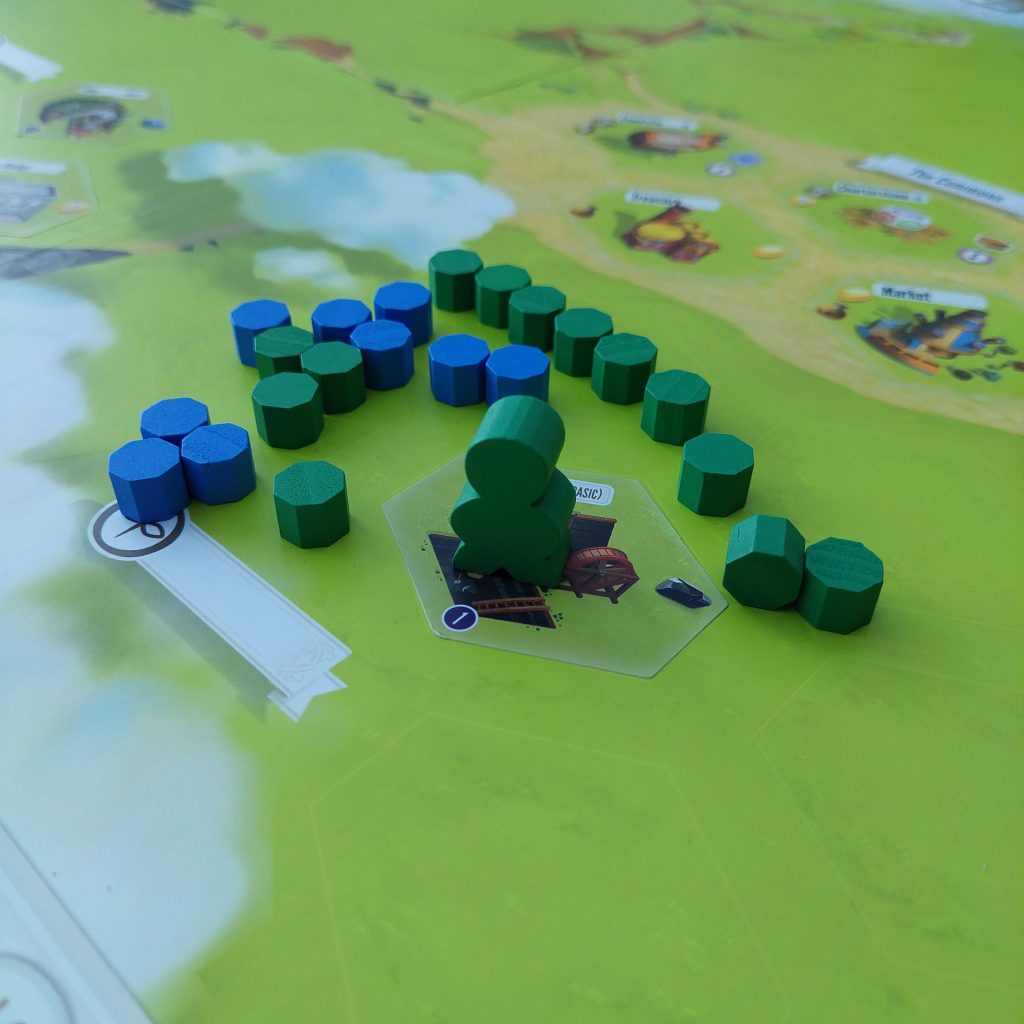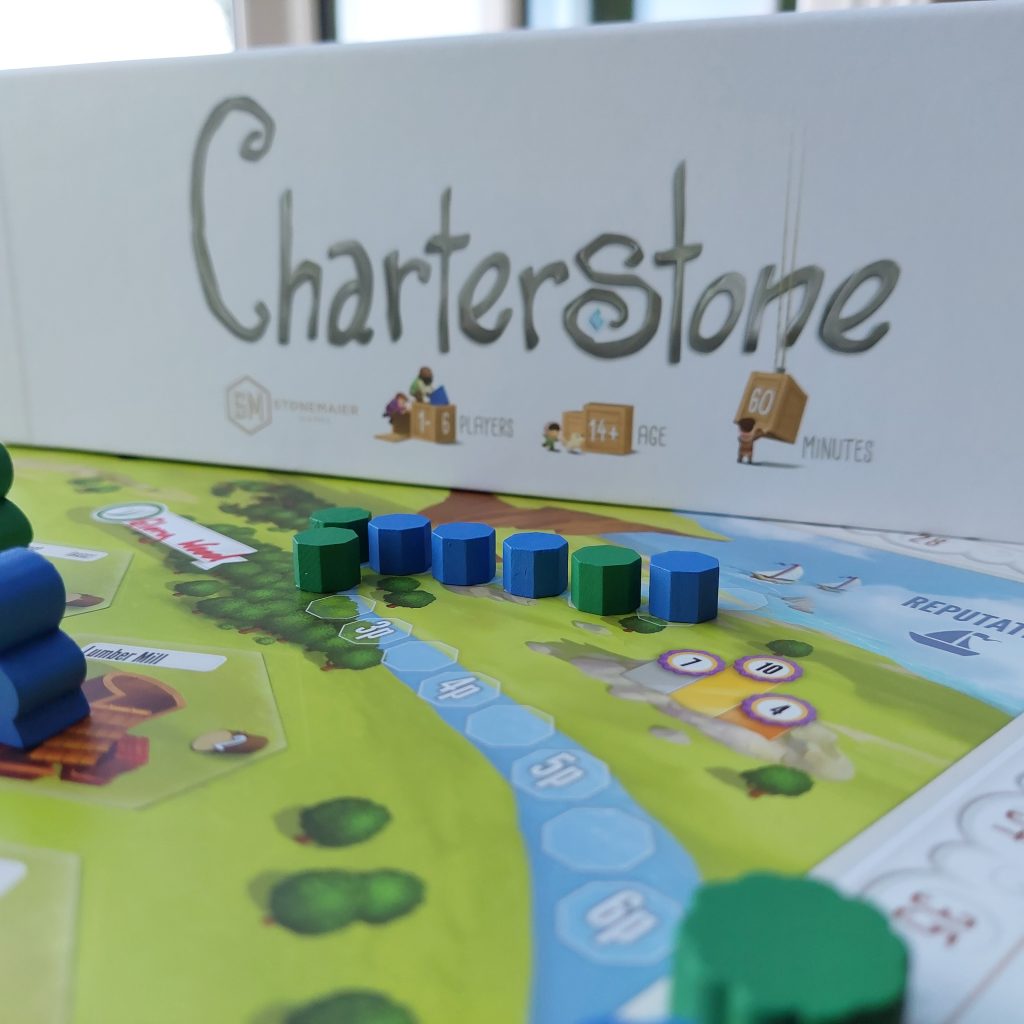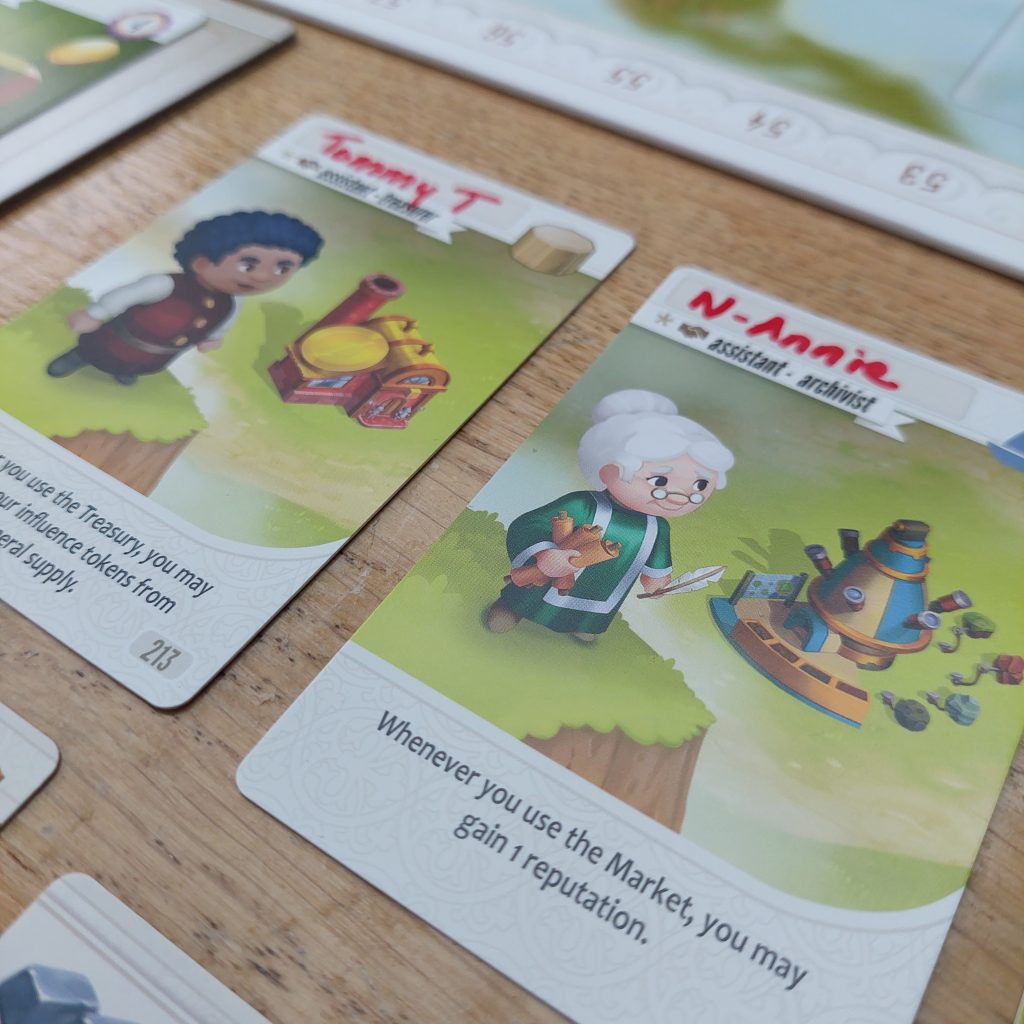Greengully is growing and growing in this lovely legacy game by Charterstone by Stonemaier Games
Publisher: Stonemaier Games
Designer: Jamey Stegmaier
Artist: Lina Cossette, David Forest
Release date: 2017
1-6 players
45-75 minutes
PLEASE NOTE THIS IS A REVIEW OF GAMES 1 – 4 (OF THE 12 CHAPTER CAMPAIGN) AND THERE ARE (HOPEFULLY!) ZERO SPOILERS!
* Open Drafting *Worker Placement * Hand Management * Competitive * Resource Management * Legacy * Campaign * Communication * Multi Player * Solo Mode * Automa Factory *

Charterstone is a 12 chapter campaign that develops as you progress through the game. Not only that, but it’s a legacy game so you are permanently changing the landscape of the Kingdom of Greengully as you go along. But we are getting ahead of ourselves……..
Kingdom of Greengully
My first encounter with Greengully was actually last year when we played Viticulture World for the first time. In that game, Greengully is an introductory continent that acts as a hand-hold around the various mechanisms that makes the co-op version of Viticulture so challenging (in a fun way!). I didn’t know it then but it was a sneak peek into this new world…….a world that changes with every game we play!
The game revolves around building out the Kingdom of Greengully. There is a shared board but each player has their own area on it where only they can build. And each player has a theme in terms of types of the building they will be adding. So one character might be focussing on buildings that need and produce wood, whilst another will be focussing on food. As such, what gets built over the course of the game becomes a mixture, just like a real city!
Each game is essentially a race – gain the most VPs before the time runs out on the progress track. How much time depends on how many players in a game. But the main VP gaining activities will push the countdown closer to the finish.
Learning as we go!
This review is intended to give our impressions of the first four games without giving too much away – nobody wants a spoiler now, do they?! And so far the journey into Greengully has been a gentle affair.

Yes, it’s a competitive game. Yes, there can ultimately be only one winner. But our first four games have felt more exploratory than edge-of-your seat tense. And that feeling is in part created by the way in which you learn this game.
As well as having a board that develops over the course of the game, so too does the rule book! Yep, a large part of these early chapters in the construction of Greengully has been the construction of the Chronicle that guides us through the dos and donts of the game! And that is certainly a novel experience for us!
And that is really interesting. Nerve-wrecking in a way. We want to know more but until the game is ready to reveal its secrets we just have to wait! I’m okay with delayed gratification, however, my husband was itching to pad out the rule book. Don’t worry, thus far I have managed to stop him from diving in too soon – I just hope I can keep up the resistance for our next few sessions!
But luckily for us, the first few games have been easy to navigate – essentially we are placing out our workers (starting with just two) on buildings which have a cost but also reward with other goodies which can then be spent in various ways. In the first few games, workers cannot share spaces, so if you want to use an occupied building, you’ll essentially be bumping back your opponent’s worker to them (giving them another action before they too have to use a turn to bring back their peeps!). When we have no more workers to place, we take them back and around it goes.
The goodies in Greengully are the main way you pay to get more buildings added to the shared board. And more buildings means more choice in terms of what abilities can be activated and what goodies can be acquired (including more workers!).

Cracking open those crates!
But you can’t just take a building card, peel off the sticker and place it on the board. The buildings are hidden in crates which are found on buildings already constructed! And you have to pay to open them. But when you do….ooh it’s like Christmas has come to Greengully! haha
The contents of each crate are found in the Index. Sounds ominous but it is a gorgeous flip open, magnetic catch box that acts as the keeper of the cards! Each crate has a number which you look up and it then tells you which cards to remove from the index. So far these have been a combination of rules, character personalities (which give you unique abilities during a specific game), game objectives, assistants, tools, and of course more buildings!

As well as opening crates, there are other ways to gain VPs. There’s a reputation track where the player with the most influence tokens will gain a big VP boost, and a market with 3 goals which you can each aim to achieve.
Influential Builders!
Ah yes, influence! We can’t forget influence. As well as basic resources and money, each player has a certain amount of influence in Greengully. Some buildings or actions require you to spend it in order to activate them. And in the early games it feels like it runs down suuuper fast. And that has the double effect of hastening the end-game trigger (because each turn that begins with zero influence pushes the countdown piece one space further along the progress track!). but as games go on and more buildings appear, this precious commodity can be better utilised, opening up new ways to eek out as much VP gaining action on a given turn as possible.

Let me be your guide(post!)
A cool aspect of Charterstone is the use of Guideposts. These come out after game two and act as surprise end-game development boosts. Interestingly, even if you have won the particular game, you might not be the player who gets to scratch-and-reveal the story development. Each guidepost has its own winning condition and whoever achieves it (independent of the final score) gets to decide which way the Greengully adventure will continue. Will you please or enrage the Forever King? It’s definitely fun to find out and can definitely go some way to making up for the disappointment of losing a game!
Ultimately winning is on each of our minds, however, and individual games are worth 6 VPs each at the end of the campaign. VP tallies for all players also get turned into glory points that ultimately boost our abilities going into the next game. Being able to choose what to spend them on is a lovely decision dilemma!
Charting our way around Greengully!
We haven’t reached the half way point quite yet but after 4 games we definitely feel like we are now doing enough to reflect on the game. The first few turns around the town were admittedly slow going. but it helped in a way as we were getting to grips with the idea of building our own rule book and navigating our way round all the icons (of which there are many although they do become pretty familiar quite fast!).
And as we have passed game 3 and 4, we have new asymmetric abilities in the form of personalities as well as assistants and new types of workers (minions), all of which require careful balance (although I can’t tell you why!) but ultimately enable us to each combo actions and get more from each worker out on the board.

Playing Charterstone at 2P does feel quite open initially – the board starts out very bare. But as we have progressed we don’t feel like we miss out by having fewer than 6 players. The buildings from the inactive charters make an appearance in ways that, as you might expect, give advantages but also restrictions. Plus, if we wanted to, we could add in the Automa system (which also allows Charterstone to be played solo!), although we have chosen to go head to head.
And it feels like it quickly becomes a game of gentle but important decision dilemmas. So far, with the workers we have, we definitely haven’t been able to do everything we want each game. And so we have been testing the water with different strategies. Some have worked, others not so much, but it shows us the variety and versatility of each new chapter!

This is a legacy game that takes personalisation and runs with it . From the board areas to the personalities of the players themselves – everything can be named which immerses you and invests you into the game. And that feels really fun as you really do feel like you are an architect of glorious Greengully.
And the components are so gorgeous that it seems almost a shame to write on some of them! Everything has its place – the Scriptorium for all the wooden components, the Charter boxes for players’ bits and bobs, more tuck boxes filled with goodies, and the Index. There’s even an Archive for disused cards! And the artwork is sweet in a cheerful, colourful style. The characters have cheeks we just want to pinch and the coins and wooden tokens are lovely. The metal coins actually deserve a special mention because, although metal is not my favourite material to handle, these are top quality upgrade-worthy coins!

It should also be noted that the game has an eternal element so that even after the campaign ends it can be played as a regular worker placement game. We aren’t there yet but I’m looking forward to trying it when we have reached the end of the 12th game. Plus the board is also double sided so that you can play the campaign all over again (with the purchase of a recharge pack).
Overall we are enjoying Charterstone now that we are picking up the pace and our meeples are working hard on combo-ing actions around the city! We are still flipping back and forth through the still-developing rules hunting for things that maybe haven’t come out yet – always having one eye on new and mysterious icons! – but it does give us a chance to remind ourselves of some of the finer rules when we do and not get overwhelmed by trying to learn everything all at once. We are looking forward to seeing our city grow and find out what is in store in our very own version of Greengully!
[Please note that a copy of this game was kindly provided by the publishers for review. I am not paid for my comments, however, and all opinions are my own]. I am also not affiliated to or sponsored by any retail store.









